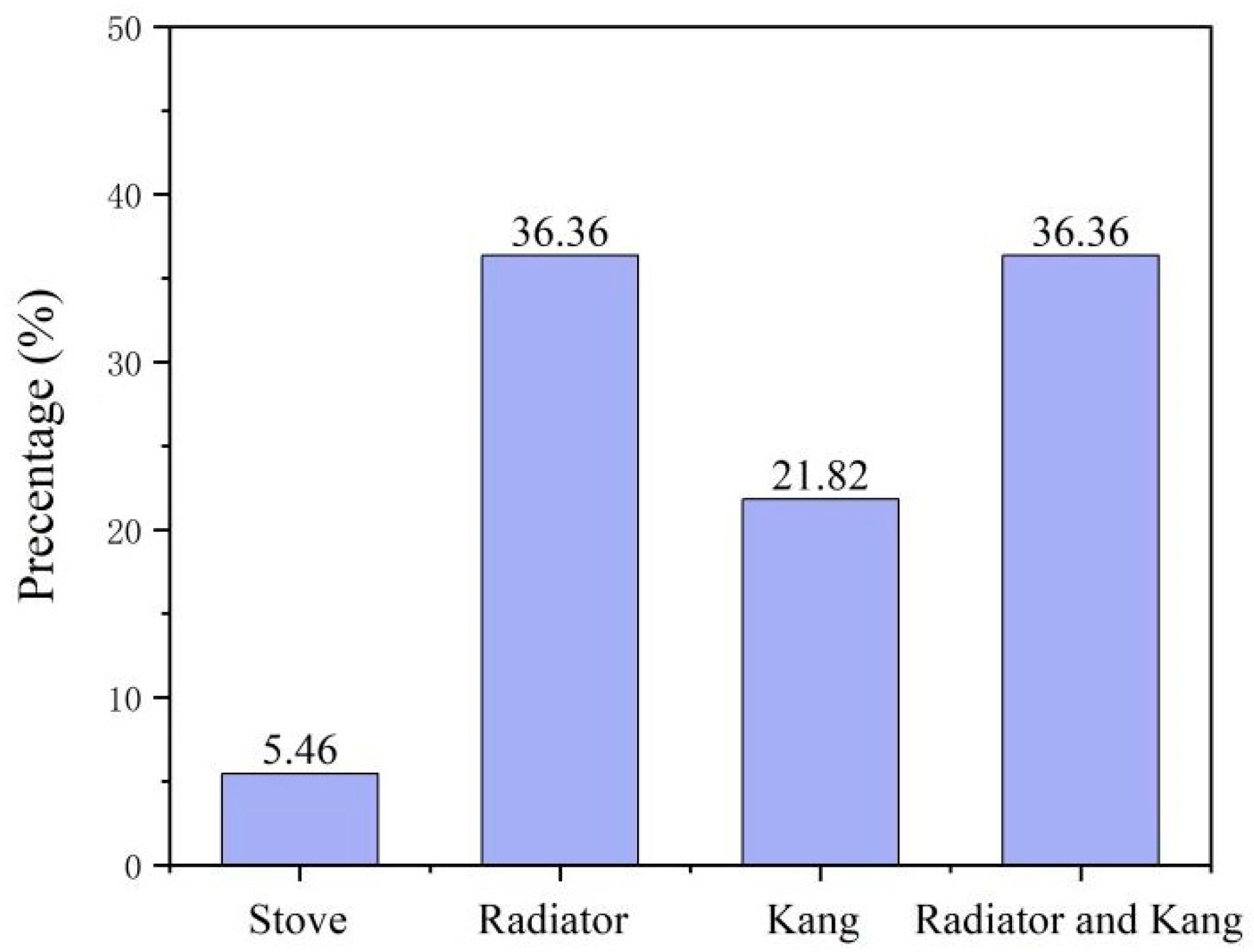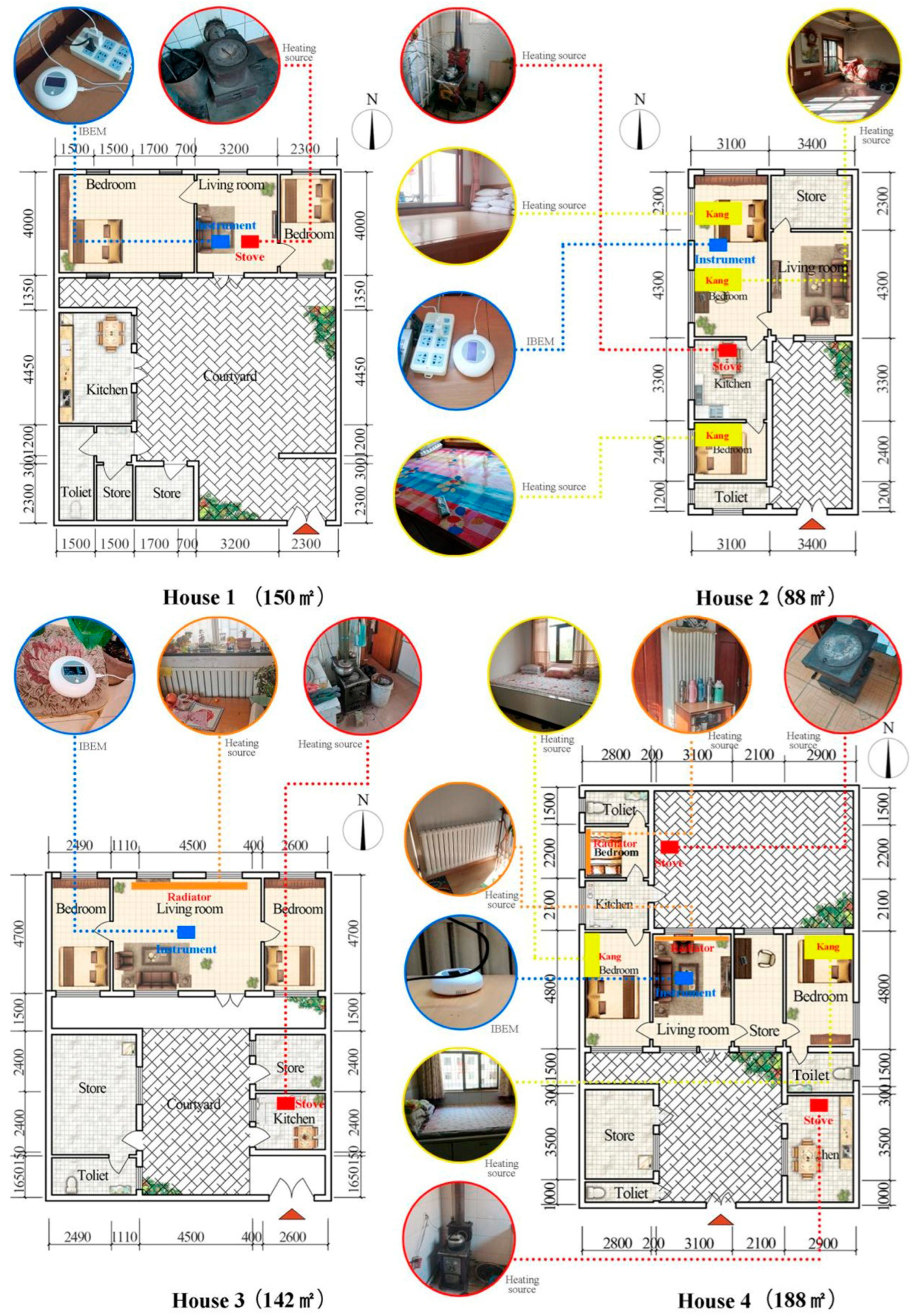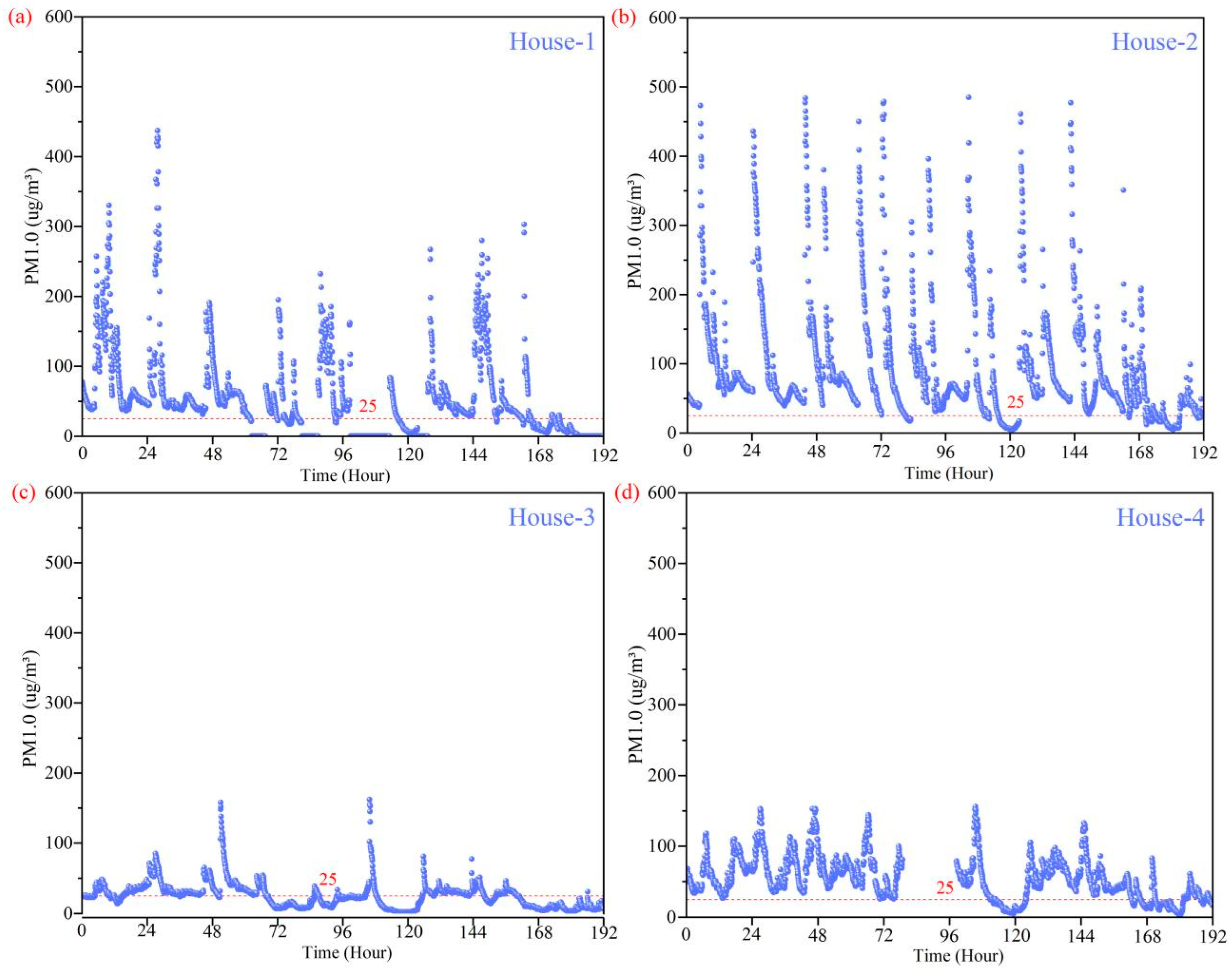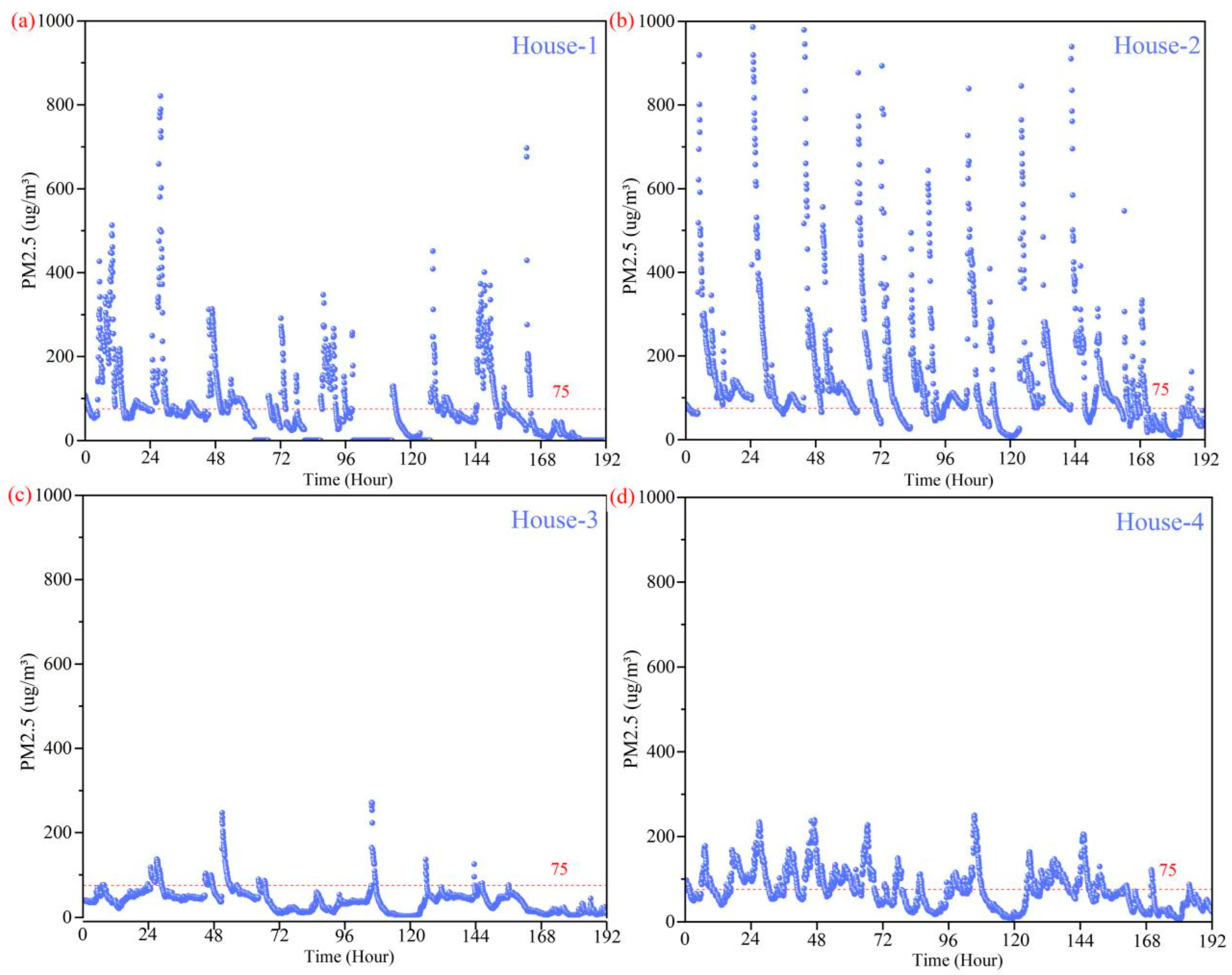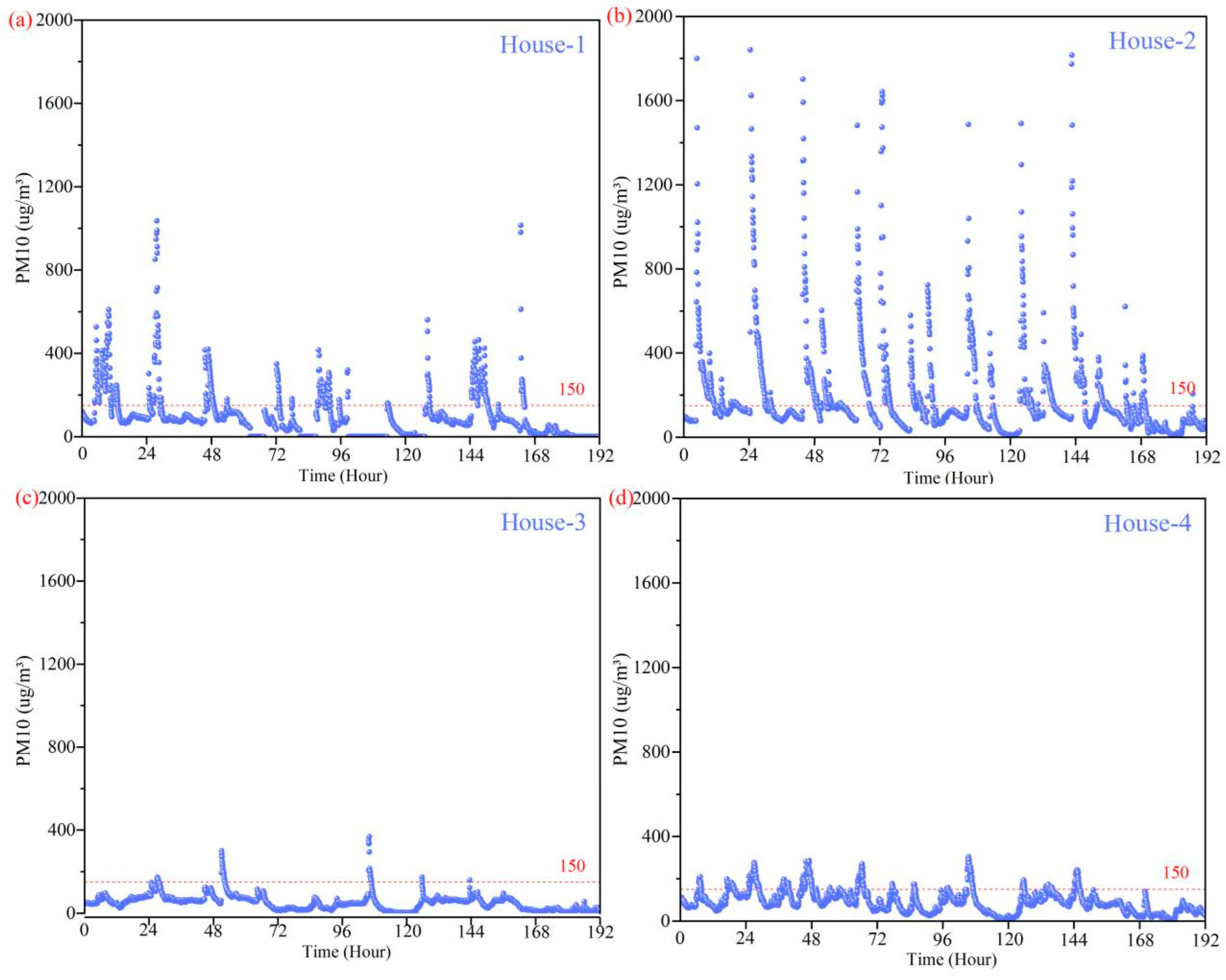1. Introduction
The rural areas of northern China are remote and tend to be economically underdeveloped with unevenly distributed energy resources [
1]. Thus, the burning of coal in winter for both food preparation and heating is common [
2]. Coal combustion is inefficient and leads to high levels of air pollution, including CO
2 and particulate matter PM 2.5 and PM 10, severely affecting the quality of indoor air [
3]. It is estimated that the pollution of ambient and indoor air by particulate matter resulted in 1.79 million premature deaths in China alone during 2019 [
3]. Therefore, the rural population in northern China is particularly prone to inhaling pollutants from coal combustion during the winter and their health is seriously affected by indoor air pollution [
4].
A study by Cheng et al. [
5] examined people’s adaptations to living in cold climatic regions of China. The authors found that people tended to wear thicker clothing, drank hot drinks, altered their activity patterns, and insulated their houses. A further study by Shao et al. [
6] recorded people’s behavior using continuous tracking for the objective assessment of environmental factors and for subjective responses, obtaining specific data on the heating needs of people in these remote areas. Zhang et al. [
7] reported that people adapt by wearing thicker clothes and heating their houses, while Wang et al. [
8] investigated adaptations in naturally ventilated houses. Neutral temperatures in the cold Harbin climate were found to be lower than those in warmer areas. Inhabitants of severely cold areas were observed to have developed specific forms of heating [
9]. Li et al. [
10] compared the indoor air quality (IAQ) of traditional dwellings constructed of rammed earth with the more commonly found buildings, finding that the inhabitants of the former experienced more comfortable thermal environments and IAQ than the residents of other dwellings. Zhao et al. [
11] investigated low-income residents in rural China, observing that they wore thicker clothing during winter to reduce heating requirements, while Li et al. [
12] observed that satisfaction with thermal conditions was associated with differences in culture and that these differences should be taken into account when formulating building standards in rural areas. Thus, additional research into the thermal environmental conditions in the rural areas of cold climatic zones is important for the inhabitants of these regions [
13,
14].
A report by Han et al. [
15] described the adverse health effects of using solid fuels for domestic heating, which was extended by the findings of Chen et al. [
16] on reduced IAQ in rural areas resulting from space heating. An comparison of the indoor environments of older people in five rural and five urban houses [
17] in Beijing, China, showed that the urban houses were associated with greater warmth and comfort during the winter months than those in rural areas due to differences in the type of heating used. Studies have proven that there are adverse effects on health from the gaseous pollutants and PM emitted during coal combustion [
18]. Li et al. [
19] recently published a review on the solid fuel combustion emitted by Chinese residents and its impact on air quality, both ambient and indoor. PM 10 has often been studied in previous research. Studies on the air quality during winter in northern China indicate poorer air quality during the cold season than in warmer weather [
20,
21]. The deep inhalation of PM 2.5 can lead to numerous adverse effects, such as the development of circulatory and respiratory diseases [
4,
22]. Fine particles can reduce lung function and cause heart disease, lung disease, and respiratory disease, and the risk is more significant for vulnerable groups, such as children, the elderly, and sufferers of cardiopulmonary disease. Gao et al. [
23] assessed the PM 2.5 inhaled daily by people using solid fuels in Tibet, southwest China, from 2006 to 2007, while Du et al. [
24] estimated the daily inhalations of PM 1.0, PM 2.5, and PM 10 by residents in rural regions of China during winter. Huang et al. [
25] calculated that the mass fraction of PM 1.0 in PM 2.5 inhaled in rural areas approached 90%. The health risk caused by PM exposure is related to mass concentration and factors, such as the distribution of particle sizes and particle diameter. Domestic coal burning results in the release of an estimated 45% of the average monthly level of fine outdoor PM 2.5, reaching 57% during hazy winter periods, exceeding the amount produced by the power and transportation industries combined [
26]. Fine particles are able to penetrate the respiratory tract deeply, even into blood vessels. They can usually absorb more toxic pollutants and have a greater impact on health. For example, a relationship was observed between levels of submicron PM 1.0 and increased premature birth risk in China [
3,
27]. It is also estimated that over 30 million premature deaths resulting from air pollution occurred in China between 2000 and 2016 [
28].
In addition, high levels of indoor CO
2 affect human health [
29] and working efficiency [
30,
31] as both short- and long-term adverse consequences that reduce the productivity of both staff and students [
32]. According to a survey conducted by Hou et al. [
3], the median annual indoor concentration of CO
2 in northwest China is higher than 1000 ppm. Wang et al. [
33] found that the concentrations of indoor CO
2 in cold regions of China during the winter months exceeded the standard. In a typical indoor environment, a higher level of CO
2 is associated with both reduced air quality and symptoms such as headache, mucous irritation, and slow performance [
34].
Indoor air quality research and field measurement activities have primarily been conducted in inland China [
35,
36,
37]. There are few studies on rural living environments in northern coastal areas, and data such as the pollutant levels in indoor environments are still insufficient. The climate environment and family structure, as well as additional factors affecting air quality, differ between inland and coastal areas. More field studies and activities need to be performed for rural dwellings in the coastal regions of northern China. Therefore, the quality of the air within four rural dwellings with different heating sources was monitored for eight days, including air temperature, relative humidity, CO
2, PM 1.0, PM 2.5, and PM 10, to investigate indoor air in rural areas along the northern coast of China and provide necessary data to enhance the quality of indoor air in these and similar regions.
4. Conclusions
Owing to the more primitive heating modes, the rural population is especially vulnerable to the inhalation of pollutants resulting from the burning of coal during the cold winters in northern China, and their health is seriously affected by indoor air pollution. There have been few investigations into indoor pollution in rural China. There is insufficient data on the living conditions and indoor pollution in the northern coastal areas of the country. This study experimentally monitored the IAQ in four rural houses over eight days to assess the relationships between the location of the heating source and the quality of the air within the houses. All of the data collected showed that the levels of CO2, PM 1.0, PM 2.5, and PM 10 within dwellings in these coastal villages were unacceptably high in comparison with the IAQ standards.
In this study, the location of the heating source was mainly analyzed on IAQ, while indoor inhabitant behavior, building thermal performance, air permeability, and other relative factors also had a certain influence on IAQ. The presented results showed the IAQ status in the typical houses employing coal-fired stoves as heating sources in rural buildings of Qingdao (China). The principal findings are described below.
- (1)
The indoor CO2 concentrations in Houses 1 and 2, where the stove was situated in the living room, were markedly higher than those in Houses 3 and 4 that had stoves in secondary rooms. Only in House 4 was the peak CO2 concentration close to 1000 ppm. In House 3, the adjacent room was connected to the living room, resulting in both average and peak CO2 levels similar to those of Houses 1 and 2. These findings indicate that stoves should be located in separate spaces as far away from the living rooms as possible.
- (2)
The peak concentration of PM 1.0 was 430–480 μg/m3 in Houses 1 and 2 where the stove was situated in the main room. Houses 3 and 4, with stoves situated in secondary rooms, had readings close to 150 μg/m3. Compared with House 3, the indoor PM 1.0 of House 4 was above the standard value of 25 μg/m3. This could be because there were two coal-fired stoves in House 4, which is more than in the other houses.
- (3)
Over the monitoring period, the peak PM 2.5 levels in Houses 1, 3, and 4 approached 200–800 µg/m3, with a peak value of 2000 µg/m3 in House 2. While peaks of PM 2.5 were apparent during food preparation, the constant fuel supply results in a series of peaks.
- (4)
The average PM 10 level in House 2 was above 150 µg/m3 with a peak value of 3894 µg/m3. However, the average PM 10 levels in Houses 1, 3, and 4 were 50–90 µg/m3, below the standard, although the peak values reached 300–1000 µg/m3. Indoor PM 10 values over the 150 µg/m3 standard can lead to organ damage, especially in children and the elderly.
- (5)
The heating sources of coal-fired stoves should be separated both from the main room and from the secondary room connected to the main room. This would reduce the indoor levels of both CO2 and particulate matter. Suitable courtyard ventilation is necessary for houses with two or more heating sources.
